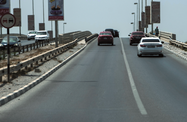The RAK Investment Authority (RAKIA) licenced 800 new companies in the first eight months of 2011, a 31% increase from the same period last year, according to Alex Thomas, RAKIA’s general manager of marketing. Most of the new licences were for manufacturing firms, and the number of trading and transport licenses was also up, Thomas said.
Indeed, as RAK’s manufacturing capacity continues to expand, other sectors that complement industry, such as transportation, stand to benefit from increased business. The transport sector in the emirate enjoys several advantages, including ongoing infrastructure investments, a location in the Gulf region and access to GCC and Middle Eastern markets.
As a territory close to the Strait of Hormuz, one of the world’s busiest shipping lanes, sea connections are a key component of RAK transport. The emirate has five ports: Saqr, Al Jazeera, Al Hamra, Al Jeer RAK Khour and RAK Maritime City (RAKMC), and upgrades on the emirate’s port capacity have been continual.
RAKMC, for example, was completed just last year. The Dh520m ($141.6m) project functions both as a harbour and as a free zone. Additions have also been completed on the dry dock at Al Jazeera Port, including 12 dry berths for medium-sized ship maintenance and repairs, port officials said in August.
Land links are also critical to the local economy, facilitating connections between RAK industrial suppliers and construction sites in neighbouring emirates. RAK authorities launched a road improvement programme in 2008 with Dh3bn ($807m) in planned investments. The project includes the RAK Ring Road, a 116-km bypass on the National Highway around RAK City. This route is likely to be particularly useful for through traffic attempting to avoid urban congestion, including cargo trucks and commuters destined for other emirates.
“People from Shamal and other northern areas of RAK travelling to Dubai, Sharjah and other emirates will no longer have to drive through the busy streets in towns,” Abdullah Yousuf, the head of the RAK Department of Public Works and Services, told the Khaleej Times in April. “The ring road will connect them directly to the Emirates Road.”
Although cars are overwhelmingly the vehicle of choice in RAK and the UAE as a whole, authorities hope railway use will grow in the long term. The Dh40bn ($10.9bn) UAE-wide Etihad Rail network is set to offer a major boost, transporting passengers and freight within the country and eventually linking to the planned GCC railway. The freight-only first stage is scheduled to have operational routes by 2013, with a second stage including passenger transport to follow, according to Etihad Rail.
At the end of the summer, the company announced two new agreements: a locomotive contract with US-based Electro-Motive Diesel and a covered wagon contract with China South Locomotive and Rolling Stock. These components are planned for use on a 266-km stretch of the project’s first stage, a sulphur transport corridor between Shah and Habshan and the port of Ruwais, according to Etihad Rail. Once rail connections are finished in the northern emirates, RAK stands to gain cheaper, faster and greener transport options.
As infrastructure in RAK expands to include less accessible areas of the emirate, other sectors such as tourism could benefit as well. Resorts like the Golden Tulip Khatt Springs, in the foothills of the Hajjar Mountains, offer a way for RAK to take advantage of its unique topography.
The 35-km Jebal Al Jais mountain road is set to provide connections to such areas of the emirate. Assuming authorities continue to build infrastructure in a way that preserves the emirate’s eco-systems and natural beauty, the Jebel Al Jais and other projects like it could do much to develop remote areas in the emirate.
The link between the successful development of all sectors, and in particular tourism and industry, and a multi-modal integrated transports system are clear. These developments stand RAK and the entire UAE well poised to optimise their geographic advantages and for longer-term sustained growth.

